Related Research Articles
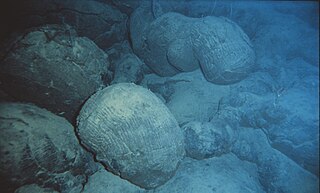
Pillow lavas are lavas that contain characteristic pillow-shaped structures that are attributed to the extrusion of the lava under water, or subaqueous extrusion. Pillow lavas in volcanic rock are characterized by thick sequences of discontinuous pillow-shaped masses, commonly up to one metre in diameter. They form the upper part of Layer 2 of normal oceanic crust.

A rock is any naturally occurring solid mass or aggregate of minerals or mineraloid matter. It is categorized by the minerals included, its chemical composition and the way in which it is formed. Rocks are usually grouped into three main groups: igneous rocks, metamorphic rocks and sedimentary rocks. Rocks form the Earth's outer solid layer, the crust.

Petrology is the branch of geology that studies rocks and the conditions under which they form. Petrology has three subdivisions: igneous, metamorphic, and sedimentary petrology. Igneous and metamorphic petrology are commonly taught together because they both contain heavy use of chemistry, chemical methods, and phase diagrams. Sedimentary petrology is, on the other hand, commonly taught together with stratigraphy because it deals with the processes that form sedimentary rock.

A phenocryst is an early forming, relatively large and usually conspicuous crystal distinctly larger than the grains of the rock groundmass of an igneous rock. Such rocks that have a distinct difference in the size of the crystals are called porphyries, and the adjective porphyritic is used to describe them. Phenocrysts often have euhedral forms, either due to early growth within a magma, or by post-emplacement recrystallization. Normally the term phenocryst is not used unless the crystals are directly observable, which is sometimes stated as greater than .5 millimeter in diameter. Phenocrysts below this level, but still larger than the groundmass crystals, are termed microphenocrysts. Very large phenocrysts are termed megaphenocrysts. Some rocks contain both microphenocrysts and megaphenocrysts. In metamorphic rocks, crystals similar to phenocrysts are called porphyroblasts.

The Thorarinsson Medal is awarded every four years by the International Association of Volcanology and Chemistry of the Earth's Interior (IAVCEI) for outstanding contributions to the general field of volcanology, and is the highest award given by IAVCEI. It is named for the Icelandic geologist and volcanologist Sigurdur Thorarinsson (1912–1983).
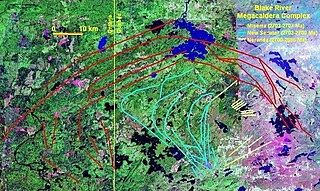
The Blake River Megacaldera Complex is a giant subaqueous caldera cluster or a nested caldera system that spans across the Ontario-Quebec border in Canada.

The New Senator Caldera is a large Archean caldera complex within the heart of the Blake River Megacaldera Complex, Quebec, Canada. It has a diameter of 15-30 kilometers and is made of thick massive mafic sequences. The caldera complex has inferred to be a subaqueous lava lake during the early stages of the caldera's development. Gabbro sills represent lava lakes, which are common in mafic summit calderas. These subaqueous lava lakes are large units with a change in grain size from coarse to fine grained and a hyaloclastite top. The Kiwanis (Norands) intrusion, a high-level synvolcanic magma chamber, intrudes felsic rocks, and is in turn cross-cut by basaltic dikes and sills.

The Noranda Caldera is a well-known large subaqueous Archean caldera complex within the Blake River Megacaldera Complex, Quebec, Canada. The caldera contains a 7-to-9-km-thick succession of bimodal mafic-felsic tholeiitic to calc-alkaline volcanic rocks which were erupted during five major series of volcanic activity.

The Misema Caldera is a 2,704-2,707 million year old caldera in Ontario and Quebec, Canada.
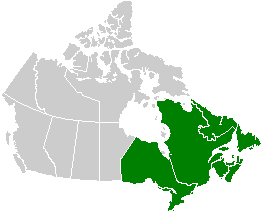
The volcanology of Eastern Canada includes the hundreds of volcanic areas and extensive lava formations in Eastern Canada. The region's different volcano and lava types originate from different tectonic settings and types of volcanic eruptions, ranging from passive lava eruptions to violent explosive eruptions. Eastern Canada has very large volumes of magmatic rock called large igneous provinces. They are represented by deep-level plumbing systems consisting of giant dike swarms, sill provinces and layered intrusions. The most capable large igneous provinces in Eastern Canada are Archean age greenstone belts containing a rare volcanic rock called komatiite.
Jack Gordon Souther was an American-born Canadian geologist, volcanologist, professor and engineer. He contributed significantly to the early understanding of recent volcanic activity in the Canadian Cordillera. Many of his publications continue to be regarded as classics in their field, even now several decades after they were written.
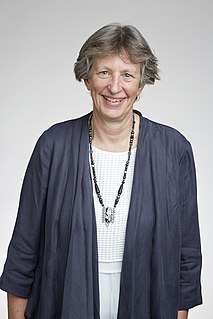
Katharine Venable Cashman is an American volcanologist, professor of volcanology at the University of Bristol and former Philip H. Knight Professor of Natural Science at the University of Oregon.
Mihir Kumar Bose (1933–2009) was an Indian geologist and a professor at the Presidency College, Kolkata. He was known for his studies on igneous petrology and was an elected fellow of the Geological Survey of India, Indian National Science Academy, and the Indian Academy of Sciences. The Council of Scientific and Industrial Research, the apex agency of the Government of India for scientific research, awarded him the Shanti Swarup Bhatnagar Prize for Science and Technology, one of the highest Indian science awards for his contributions to Earth, Atmosphere, Ocean and Planetary Sciences in 1976.
Dominique Weis is a Canadian scientist. She is a Canada Research Chair in the Geochemistry of the Earth's Mantleat at the University of British Columbia.
Alok Krishna Gupta is an Indian mineralogist, petrologist and a former Raja Ramanna Fellow of the Department of Atomic Energy at the National Centre of Experimental Mineralogy and Petrology of the University of Allahabad. He is known for his studies on the genesis of alkaline rocks and is an elected fellow of all three major Indian science academies viz. the National Academy of Sciences, India, Indian National Science Academy and the Indian Academy of Sciences. The Council of Scientific and Industrial Research, the apex agency of the Government of India for scientific research, awarded him the Shanti Swarup Bhatnagar Prize for Science and Technology, one of the highest Indian science awards for his contributions to Earth, Atmosphere, Ocean and Planetary Sciences in 1986.
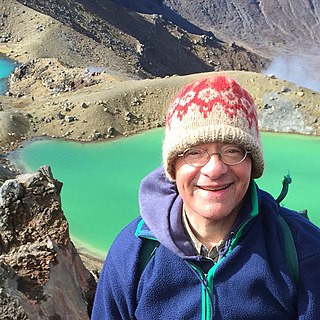
Mark S. Ghiorso is an American geochemist who resides in Seattle, Washington. He is best known for creating MELTS, a software tool for thermodynamic modeling of phase equilibria in magmatic systems.
Marie Edmonds is a volcanologist and geologist at the University of Cambridge whose research focuses on the physics and chemistry of volcanic eruptions, with a focus on understanding volatile cycling in the solid Earth. Prof. Edmonds is the Ron Oxburgh Fellow in Earth Sciences at Queens' College, Cambridge.
Anat Shahar is a staff scientist at the Geophysical Laboratory, Carnegie Institution of Washington and adjunct Professor at the University of Maryland. Her work uses high-pressure, high-temperature experiments and stable isotope geochemistry to understand the formation of planets in the solar system.
John Verhoogen was a Belgian-American geologist and geophysicist.
References
- 1 2 "Career Achievement Award". Geological Association of Canada. Archived from the original on 2014-03-24. Retrieved 2014-06-18.
- ↑ "Past Recipients". Geological Association of Canada. Archived from the original on 2016-12-20. Retrieved 2014-06-18.